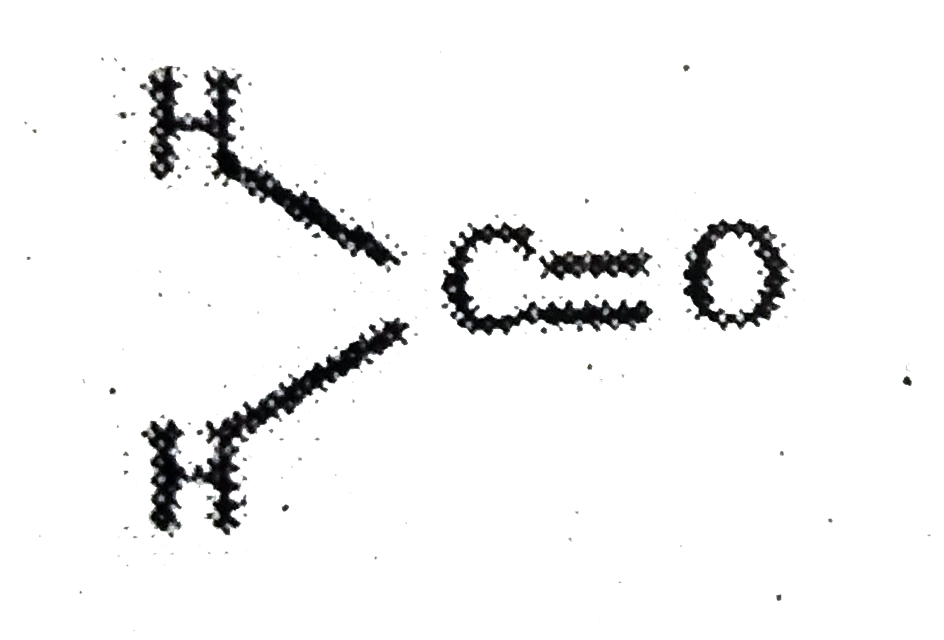Assertion : In formaldehyde all the four atoms lie in one plane.
Reason : Carbonyl carbon forms a π-bond with oxygen by overlapping of p -orbitals.
If both assertion and reason are true and reason is the correct explanation of assertion.
If both assertion and reason are true but reason is not the correct explanation of assertion.
If assertion is true but reason is false.
If both assertion and reason are false.
The correct Answer is:B
To analyze the assertion and reason provided in the question, we will break down the concepts step by step.
Step 1: Understanding the Assertion
The assertion states that "In formaldehyde, all four atoms lie in one plane."
Explanation:
Formaldehyde (H₂C=O) consists of a carbon atom (C) double-bonded to an oxygen atom (O) and single-bonded to two hydrogen atoms (H). The carbon atom is at the center, with the two hydrogen atoms and the oxygen atom arranged around it.
Step 2: Determining the Hybridization
To understand the geometry of formaldehyde, we need to determine the hybridization of the carbon atom.
Explanation:
The carbon atom in formaldehyde has three regions of electron density: one double bond with oxygen (which consists of one sigma and one pi bond) and two single bonds with hydrogen. The hybridization can be determined as follows:
- Number of sigma bonds = 3 (2 from H and 1 from O)
- Number of lone pairs on carbon = 0
Using the formula for hybridization:
Hybridization=Number of sigma bonds+Number of lone pairs
Hybridization=3+0=3
This indicates that the carbon is sp² hybridized.
Step 3: Geometry of the Molecule
With sp² hybridization, the geometry of formaldehyde can be predicted.
Explanation:
In sp² hybridization, the molecular geometry is trigonal planar. This means that all atoms connected to the carbon atom (the two hydrogens and the oxygen) will lie in the same plane. Therefore, the assertion is true.
Step 4: Analyzing the Reason
The reason states that "Carbonyl carbon forms a pi-bond with oxygen by overlapping of p-orbitals."
Explanation:
In formaldehyde, the carbon atom forms a double bond with the oxygen atom. This double bond consists of one sigma bond (formed by the overlap of sp² hybridized orbitals from carbon and an sp² hybridized orbital from oxygen) and one pi bond (formed by the side-to-side overlap of the unhybridized p-orbitals from carbon and oxygen). This pi bond contributes to the planar structure of the molecule.
Step 5: Conclusion
Both the assertion and the reason are true, and the reason correctly explains the assertion.
Final Answer:
Both the assertion and the reason are correct, and the reason explains the assertion.
The assertion states that "In formaldehyde, all four atoms lie in one plane."
Formaldehyde (H₂C=O) consists of a carbon atom (C) double-bonded to an oxygen atom (O) and single-bonded to two hydrogen atoms (H). The carbon atom is at the center, with the two hydrogen atoms and the oxygen atom arranged around it.
To understand the geometry of formaldehyde, we need to determine the hybridization of the carbon atom.
The carbon atom in formaldehyde has three regions of electron density: one double bond with oxygen (which consists of one sigma and one pi bond) and two single bonds with hydrogen. The hybridization can be determined as follows:
- Number of sigma bonds = 3 (2 from H and 1 from O)
- Number of lone pairs on carbon = 0
Hybridization=Number of sigma bonds+Number of lone pairs
Hybridization=3+0=3
This indicates that the carbon is sp² hybridized.
With sp² hybridization, the geometry of formaldehyde can be predicted.
In sp² hybridization, the molecular geometry is trigonal planar. This means that all atoms connected to the carbon atom (the two hydrogens and the oxygen) will lie in the same plane. Therefore, the assertion is true.
The reason states that "Carbonyl carbon forms a pi-bond with oxygen by overlapping of p-orbitals."
In formaldehyde, the carbon atom forms a double bond with the oxygen atom. This double bond consists of one sigma bond (formed by the overlap of sp² hybridized orbitals from carbon and an sp² hybridized orbital from oxygen) and one pi bond (formed by the side-to-side overlap of the unhybridized p-orbitals from carbon and oxygen). This pi bond contributes to the planar structure of the molecule.
Both the assertion and the reason are true, and the reason correctly explains the assertion.
Both the assertion and the reason are correct, and the reason explains the assertion.
Topper's Solved these Questions
- ALDEHYDES, KETONES AND CARBOXYLIC ACIDSBook:NCERT FINGERTPS ENGLISHChapter:ALDEHYDES, KETONES AND CARBOXYLIC ACIDSExercise:Nomenclature And Structure Of Carbonyl Group
Explore 3 Videos
- ALDEHYDES, KETONES AND CARBOXYLIC ACIDSBook:NCERT FINGERTPS ENGLISHChapter:ALDEHYDES, KETONES AND CARBOXYLIC ACIDSExercise:Preparation Of Aldehydes And Ketones
Explore 11 Videos
- ALDEHYDES, KETONES AND CARBOXYLIC ACIDSBook:NCERT FINGERTPS ENGLISHChapter:ALDEHYDES, KETONES AND CARBOXYLIC ACIDSExercise:NCERT ( EXEMPLAR PROBLEMS )
Explore 11 Videos
- ALCOHOLS,PHENOLS AND ETHERSBook:NCERT FINGERTPS ENGLISHChapter:ALCOHOLS,PHENOLS AND ETHERSExercise:Assertion And Reason
Explore 14 Videos
- AMINES Book:NCERT FINGERTPS ENGLISHChapter:AMINES Exercise:ASSERTION & REASON CORNER
Explore 14 Videos
Similar Questions
Assertion:In formaldehyde, all the four atoms are in the same plane

Reason:The carbon atom in formaldehyde is sp3 hybridized
View SolutionIn which of the following molecules all the atoms lie in one plane ? .
View SolutionIn which of the following molecules all the atoms lie in one plane ? .
View SolutionAssertion (A) : All the C atoms of but-2-ene lie in one plane
Reason (R): Double-bond C atoms are sp2-hypbridised.
View SolutionWhat type of covalent bonds are formed during the overlapping of
p-p atomic orbitals?
View SolutionWhat type of covalent bonds are formed during the overlapping of
s-p atomic orbitals?
View SolutionWhat type of covalent bonds are formed during the overlapping of
s-s atomic orbitals?
View SolutionAssertion:- If dx2y2 and py orbitals come close together along z-axis, then can form π−bond by sideways overlapping.
Reason:- Both orbitals do not have electron density along z-axis.
View Solutionpy-orbital can not form π -bond by lateral overlap with :
View Solutionpy-orbital can not form π -bond by lateral overlap with :
View Solution
